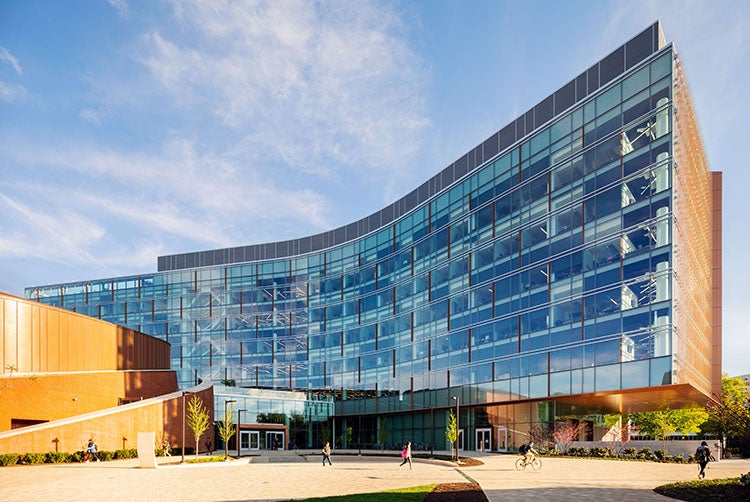
Planning for the Future of Engineering Schools
Today’s engineering schools are imagining their future amidst changing societal expectations and an evolution of pedagogy. Campus facilities planning offers an opportunity to position the physical environment as a critical asset that can facilitate change over time.
James Plummer, Stanford engineering professor and former dean, recently stated that “The half-life of engineering knowledge is three to five years.” This statement bluntly reflects the current reality for academic institutions grappling with how to create or maintain competitive engineering programs amidst growing demand. In this article, we look at what the rapid rate of change within engineering disciplines means for pedagogy, strategic planning, and physical space.

Key Trends Driving Change in Engineering Schools
Prioritizing “Just-in-Time” Knowledge and Project-Based Learning
Advances in technology and business are placing new demands on engineering schools. Programs are stretched to offer foundational education upon which students can build along with current, relevant, just-in-time technical expertise — all in an environment where creativity, innovation and the propensity to tackle large, global problems thrive. Academic leaders must critically assess whether they are offering potential students both what they find attractive and what they need to be successful.
The best engineering schools provide students with real-world opportunities, critical thinking and entrepreneurial skills. They incorporate more cooperative learning, interdisciplinary curricula and lifelong learning opportunities into their programs. Some forward-thinking institutions are reinventing the entire engineering educational model. For example:
- Iron Range Engineering: Far from a traditional engineering school, Iron Range Engineering in Minnesota is “designed to meet the national call for a new approach to educate engineers.” The school offers a four-year engineering bachelor’s degree with certification through Mankato State University. In years 3 and 4, classes are structured entirely around semester-long industry sponsored endeavors using a project-based learning approach. The program easily accommodates students transferring from community colleges who might be less likely to pursue an engineering degree otherwise.
- Charles Sturt University: CSU outside of Sydney, Australia, offers a five-and-a-half-year joint bachelor of technology/master of engineering program in Civil Systems. While 18 months are spent on-campus with a project-based curriculum, four years of the curriculum is oriented around off-campus, work-based learning. Notably, almost all ‘technical engineering content’ is delivered online and available to students as and when they need it.
While these developments are challenging long-held conventions related to how to structure engineering education programs, institutions are simultaneously dealing with more pragmatic issues.

Demand for Engineering and Computer Science Degrees on the Rise
Over the last 10 years, the number of Bachelor’s, Master’s, and Doctoral engineering degrees conferred has increased significantly across almost every discipline—most notably, biomedical, manufacturing and materials, computer and electrical, and petroleum engineering. This has forced many institutions to think critically about space utilization, new real estate, and how to best position their programs for both continued growth and an increase in inter-disciplinary and project-based learning.
Rapid growth in fields such as robotics, artificial intelligence, cyber security and data science is drawing students to computer science programs. Unbalanced enrollment growth for institutions with these programs embedded in their engineering schools can come at the cost of other engineering disciplines within the school. These near-term trends are likely to continue and then plateau, creating a scenario where institutions need to accommodate the expanding student census in real-time.
So how do facilities need to evolve to support these trends related to both changing pedagogy and program growth?

Campus Facilities Planning Amidst Constant Change
Capital planning for the future of engineering schools must consider the implications of significant curricula and discipline shifts and provide solutions that allow institutions to quickly adapt to both anticipated and unknown future changes. Strategic facilities plans informed by subject matter expertise and real-time data can help institutions quickly adapt when needed. For example:
- A confidential university in Australia recently engaged HDR’s higher education and data-driven design teams to help accommodate growth for their science and engineering program. Through efforts informed by both data and subject matter expertise related to lab and academic planning, HDR was able to define a clear strategy for reuse of existing space, quantify and describe additional space needs in detail, and recommend different scenarios for accommodating growth that would not have been possible using traditional planning methodologies. Additionally, the University now has a digital platform that they can use, in collaboration with HDR, to revise and modify the scenario models over time as conditions and needs change.
Regardless of the strategies an institution embraces, a priority should be placed on supporting growth where necessary but retaining the flexibility to change the use of teaching spaces over a period of several years. This requires consideration of higher electrical loads, wireless capability and speed, and more exacting environmental parameters for light control, heat gain and acoustics than traditional engineering teaching space may have required.
While facilities planning for engineering schools can pose some challenges, it also provides a unique opportunity to assure that pedagogy, institutional goals, and facility utilization are all working together to provide the highest return on investment.


